ITEM SUCCESSFULLY ADDED TO CART
LEARNING CENTER
GOLD
KARAT DEFINED
Gold is one of the world's most precious metals and is the oldest known to humankind. Due to gold's magnificent properties and wonderful luster, it is considered to be the most important metal in jewelry making.
The purity of gold is measured in Karats and is now also measured in terms of fineness (i.e. European Marking). Pure gold is 24 Karats or 1000 fineness. The process of understanding what exactly a Karat is becomes rather simple when gold is thought of as an alloy (a mixture of various metals) where the karats define the percent of pure gold in the alloy. Therefore, you may determine the percentage of pure gold in any gold piece by dividing the karat by 24 (e.g. 18K gold: 18/24=0.750=75% pure gold).
The following table clarifies this:
Nothing less than 10-karat gold can be legally marked or sold as gold jewelry in the United States. The legal requirements for minimum gold content vary widely country-by-country (e.g. 9 Karat is popular in Britain, while in France, Italy and Switzerland, 18k is the lowest permissible standard to be called gold).
The purity of gold is measured in Karats and is now also measured in terms of fineness (i.e. European Marking). Pure gold is 24 Karats or 1000 fineness. The process of understanding what exactly a Karat is becomes rather simple when gold is thought of as an alloy (a mixture of various metals) where the karats define the percent of pure gold in the alloy. Therefore, you may determine the percentage of pure gold in any gold piece by dividing the karat by 24 (e.g. 18K gold: 18/24=0.750=75% pure gold).
The following table clarifies this:
|
|
|
Karat | Parts Gold to Alloy | Percent Pure Gold | Fineness (i.e. European Marking) |
|
|
|
|
|
10K | 10/24 | 41.67% | 417 |
|
|
|
|
|
14K | 14/24 | 58.33% | 583 |
|
|
|
|
|
18K | 18/24 | 75.00% | 750 |
|
|
|
|
|
24K | 24/24 | 99.99% | 999 |
|
|
Nothing less than 10-karat gold can be legally marked or sold as gold jewelry in the United States. The legal requirements for minimum gold content vary widely country-by-country (e.g. 9 Karat is popular in Britain, while in France, Italy and Switzerland, 18k is the lowest permissible standard to be called gold).
THE COLORS OF GOLD
Gold alloys, aside from strengthening gold for jewelry, can also affect its color. The following table demonstrates the most common colors of gold alloys and the metals used in making them:
|
|
|
Color Of Gold | Additional Metals Used |
|
|
|
|
|
Yellow Gold | Copper, Silver |
|
|
|
|
|
White Gold | Nickel, Zinc, Copper |
|
|
|
|
|
Green Gold | Silver, Zinc, Copper |
|
|
|
|
|
Rose Gold | Copper, Silver |
|
|
COMMON GOLD ABBREVIATIONS
There are several different abbreviations for Karat that should be known. The following table demonstrates the most common of them:
|
|
|
Abbreviation | Meaning |
|
|
|
|
|
YG or KY | Yellow Gold |
|
|
|
|
|
WG or KW | White Gold |
|
|
|
|
|
K or KT | Karat |
|
|
A NOTE OF CAUTION WHEN PURCHASING GOLD
It is very important to verify that when your paying for solid gold, you're getting it! When purchasing gold products from us, we guarantee that everything
is solid. We do not sell any products that are gold plated, filled, bonded, etc. These items are much less expensive than solid gold. Common things to watch
out for, unless you're specifically intending to purchase, are:
Vermeil - Vermeil is Gold Plated Sterling Silver
Gold Plated - Gold Plated (GP or KGP or RGP) items have a very thin layer of gold electroplated to the surface of the item. They have some other type of (base) metal underneath. GP items are always less expensive than their Gold Filled counterparts.
Gold Filled - Gold Filled (GF or KGF) is a layer of 10Kt or better gold mechanically bonded under heat & pressure to one or more surfaces of supporting base metal, then rolled or drawn to a given thickness. The amount of real gold used is why GF items are always much more expensive than their gold plated counterparts.
Vermeil - Vermeil is Gold Plated Sterling Silver
Gold Plated - Gold Plated (GP or KGP or RGP) items have a very thin layer of gold electroplated to the surface of the item. They have some other type of (base) metal underneath. GP items are always less expensive than their Gold Filled counterparts.
Gold Filled - Gold Filled (GF or KGF) is a layer of 10Kt or better gold mechanically bonded under heat & pressure to one or more surfaces of supporting base metal, then rolled or drawn to a given thickness. The amount of real gold used is why GF items are always much more expensive than their gold plated counterparts.
PROPER CARE FOR YOUR GOLD
A little time and effort on your part will keep your gold jewelry looking new from the day you purchase it. Gold is lasting and durable but can get scratched or dented if
treated roughly. The most important steps to care for your gold jewelry include:
- Make sure that all jewelry is removed during rough work or when handling harsh chemicals. Gold's worst enemy is chlorine, so be careful not to wear it in swimming pools or Jacuzzis.
- It is generally best to clean your jewelry with warm water, mild soap (not detergent), and a soft toothbrush. Rinse under warm running water and pat dry with a soft, lint-free cloth.
- Store it in a fabric-lined box away from other pieces to preserve it from getting scratched
- Periodically inspect your gold for weakness or damage and take it to a professional jeweler for immediate repair if you notice any deterioration. Your jeweler will be able to preserve it for you.
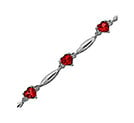 Bracelets
Bracelets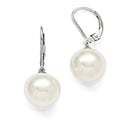 Earrings
Earrings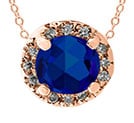 Necklaces & Pendants
Necklaces & Pendants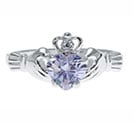 Rings
Rings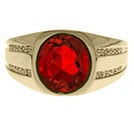 Men's Jewelry
Men's Jewelry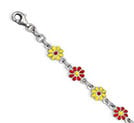 Children's Jewelry
Children's Jewelry











